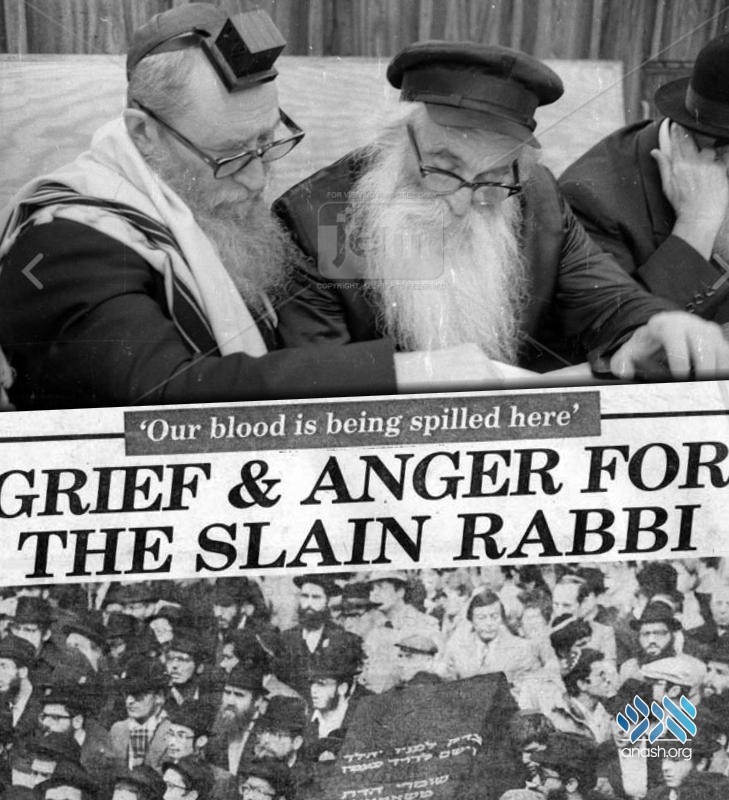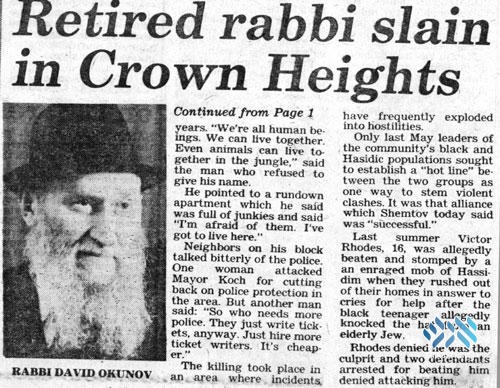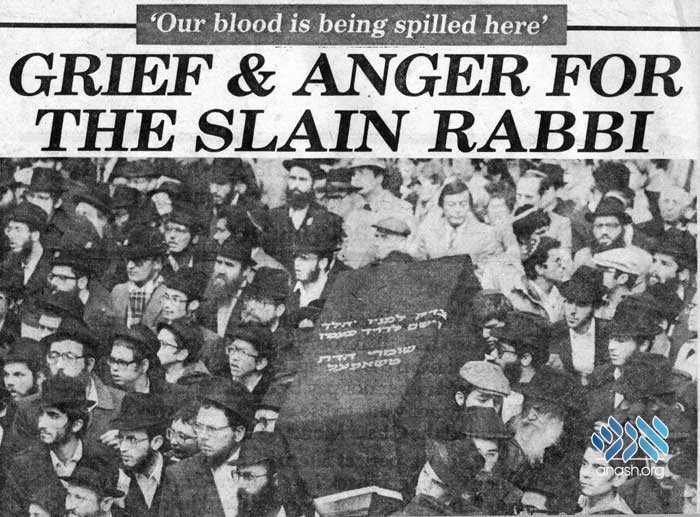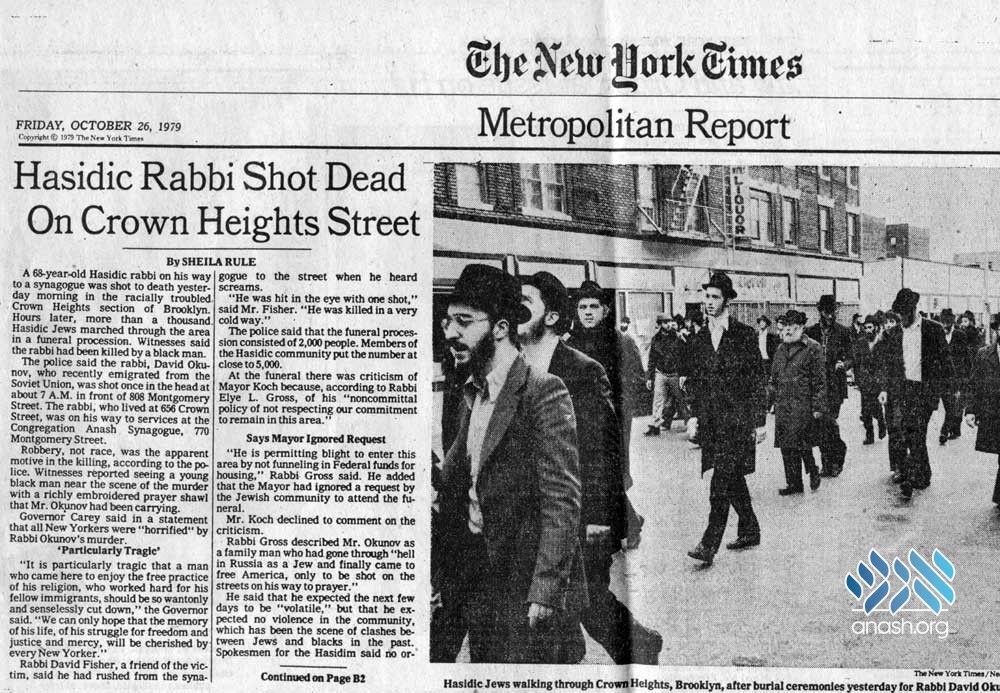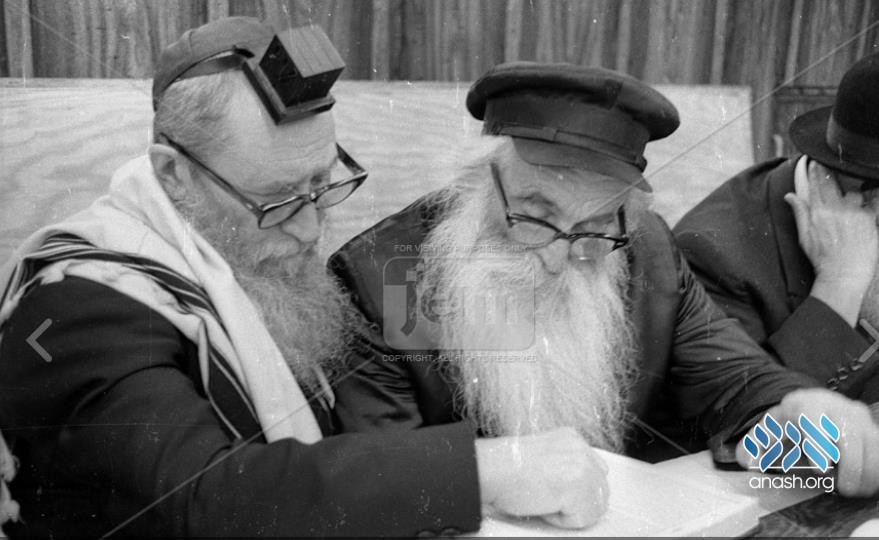This week will mark the 42nd yahrzeit of Rabbi Dovid Okunov, who was brutally gunned down at the age of 68 on his way to the morning shachris service on Montgomery Street in Crown Heights.
A Kiddush will be held this Shabbos at FREE Shul in Crown Heights to mark the 42nd Yartzeit of the Chossid Rabbi Dovid Okunov obm. All are welcome.
By Ray Kestenbaum
This week will mark the 42nd yahrzeit of Rabbi Dovid Okunov, who was brutally gunned down at the age of 68 on his way to the morning shachris service on Montgomery Street in Crown Heights.
On Thursday, October 25, 1979 (Daled Cheshvan) at 7 a.m., Reb Dovid, as he was affectionately known, was shot in the head with one bullet. A much-beloved Torah teacher and community worker, Reb Dovid died at the scene. The entire Lubavitch community and Jews in New York were in a state of shock when the murder story appeared in the New York Times and Daily News.
Over 3,000 Lubavitch chassidim attended his funeral later on that day, and he was laid to rest at the Old Montefiore Cemetery in Queens not far from the resting place of the 6th Lubavitcher Rebbe.
The then New York State Governor Hugh Carey declared that all New Yorkers were “horrified” by Rabbi Okunov’s murder. He said, “It is particularly tragic that a man who came here (from the Soviet Union) to practice his religion should be so wantonly and senselessly cut down. We can only hope,” said Carey, “that the memory of his life, of his struggle for freedom, justice and mercy, will be cherished by every New Yorker.”
Days after the killing, an African-American teenager, Caroll Miller of Crown Heights, was arrested and jailed. Police classified the murder motive as a robbery and not as a racist incident. He was tried and sentenced to 22 years on charges of premeditated murder.
“Reb Dovid did not die alone or without a rich legacy,” said a mourner. “He left a remarkable family of askanim, activists for Yiddishkeit. He had a noble history as a lifelong fighter for Judaism in the Soviet Union in times and places when the practice of Yiddishkeit was risky, even mortally dangerous.”
At a special Motzai Shabbat farbrengen, during the Shiva, the Lubavitcher Rebbe spoke of the horrifying loss of Reb Dovid’s life. “He was a man who sacrificed his life in Russia. He succeeded in escaping and coming to this free land only to be murdered on his way to do a mitzvah.”
At that farbrengen, the Rebbe broke down and cried—he had known Reb Dovid in Russia since 1926 when Reb Dovid was a student and the Rebbe was about to become the son-in-law of the 6th Lubavitcher Rebbe, Rabbi Yosef Yitzchok Schneersohn. Hundreds of chassidim, seeing the Rebbe in tears, also cried at the senseless loss of such a beloved chassidic figure.
But the Rebbe composed himself and announced that a yeshiva would be built “over his grave,” specifically a Jewish day school dedicated to serving the needs of boys from the Soviet Union. The Rebbe suggested that the new Torah institution be called Yeshivat Ohel Dovid in tribute Rabbi Dovid Okunov, who, at the time of his murder, was working to help Jews who were trapped behind the Iron Curtain.
Yeshivat Ohel Dovid, located in Lubavitch Yeshiva’s main seminary, Tomchei Temimim, on Ocean Parkway, has, since its founding in 1979, educated boys of Russian parentage in both Torah studies and a range of secular subjects. Both an elementary and high school, Yeshivat Ohel Dovid, under the auspices of Friends of Refugees of Eastern Europe (FREE), is fully accredited by New York State and the Board of Regents. The school has seen over a thousand Russian-American students pass through its portals to become ba’alei teshuva, b’nei Torah and enter some of the best colleges on the East Coast. Its alumni range professionally from doctors, lawyers and engineers to business people and even mechanchim, teachers in Jewish day schools.
Model of a Chabad Fighter
The story of Dovid Okunov is the story of a Lubavitch hero who embodied some of the basic elements of what has made the movement tick and propelled it to grow. Born in 1911 in Ukraine during the primacy of the 5th Lubavitcher Rebbe, Rabbi Sholom Dovber Schneersohn, young Dovid from childhood on displayed an irrepressible devotion and love of Yiddishkeit.
He grew up in times of repression and need. When the Socialist revolution broke out, it was near impossible to live as a practicing Jew. His parents, Reb Ephraim and Mrs. Esther Okunov, hired a home melamed to start him off in davening, Tanach and Mishna.
At age 13, after his bar mitzvah, he insisted on studying at the underground Tomchei Temimim Yeshiva in Kremenchuk, Ukraine, which was organized by the previous Rebbe.
Dovid’s parents objected; times were dangerous. So Dovid mounted a hunger strike for two days and his parents relented. The yeshiva, running counter to everything the new Communist regime stood for, taught him gemarah, halacha, Jewish history and bolstered his readiness to show a mesirat nefesh, a self-sacrifice, for Judaism.
Dovid was not only a devoted Torah student but he went out to teach Torah to others in makeshift classes and underground chadarim. He became a talmid chochom, a melamed and a staunch Lubavitch chossid.
In 1926, while learning a difficult passage in the tractate Baba Metzia with his chavrusa (study partner), Rabbi Nochum Labkovsky, a striking-looking young man walked into the beis midrash and began to enlighten them on the difficulty of the subject. The students were very gratified. The visitor turned out to be Rabbi Menachem Mendel Schneerson, the soon-to-be son-in-law of the 6th Lubavitcher Rebbe and 24 years later the 7th Lubavitcher Rebbe.
Years later, in 1964, the Rebbe returned a letter to Reb Dovid in which he signed off as M. Zeide. The Rebbe did it so as not to endanger Reb Dovid. Reb Dovid addressed the Rebbe as “Zeide” because the KGB, the Communist secret police, was aware of Rabbi Schneerson in America. Any affiliation with religion was strictly forbidden and interception and censoring of mail was routine. In his letter, the Rebbe alluded to Reb Dovid leaving Russia. He wrote to him in Russian:
“To my dear grandson Dovid,
Shalom.
I was very happy to receive regards from you. I was also very pleased to be informed that you have received an ‘invitation’ to live together with your relatives, and I wish you much happiness. May Hashem Yisborach grant that all your wishes be fulfilled without any difficulties in the most complete measure. And may we all stand together in time for the Chagim.
With best wishes to all of you for the New Year,
M. Zeide”
Ironically, Reb Dovid and the Rebbe were not that different in age, but the Rebbe, had an incredible love for his chassidim as a brother, father and grandfather and that love was returned unconditionally as brothers, children and grandchildren.
The Okunov’s were uprooted and forced to move several times under the Communist ban on religion. They chose Asian cities like Tashkent and later Samarkand, both of which had small Jewish, even Lubavitch communities. The Communist officials in Asia were more lenient on the populace than their counterparts in European cities. Yet the KGB learned that Reb Dovid was a follower of Rabbi Schneersohn in America and that was considered a good reason for arrest, trial and imprisonment in Siberia.
The Soviet secret police came to Tashkent in 1947 to arrest Reb Dovid. They knocked on his door, but he was not home at the time. Rabbi Zeev-Volf Sirota, a concerned neighbor, and friend who noticed that the KGB was after him, went to the city to find Reb Dovid. Finding him at work, they notified him that the KGB was at his door. Reb Dovid took no chances and sent a message to his wife through Rabbi Sirota to notify her that he would not be coming home and that he was taking the next train to Ukraine to visit his parents. Reb Dovid left immediately and his wife joined him shortly afterward. After a few days of visiting his home, the KGB temporarily gave up their search.
Family life, however, did flourish among chassidim in the Soviet Union under all conditions. Reb Dovid married Bassia Rivkah Zubarovsky from the chassidic town of Nevel and they had four children: Meir, Hershel, Mendel and Ida. But Mrs. Okunov suffered from a weak heart and she passed away in 1965, one year after Reb Dovid heard from the Rebbe and three years before he immigrated with his children to Israel.
Soon after his arrival in 1967, the Rebbe asked Reb Dovid to assist the Ezras Achim organization, to help Russian Jews still locked up in the Soviet Union.
The Rebbe had a premonition that the Communist empire wouldn’t last much longer and he was right. Together with Reb Dovid’s sons, the Rebbe founded FREE as an organization to help arriving refugees from Eastern Europe with their material, educational and spiritual needs. The Rebbe’s vision was prophetic and FREE has since stood the test of time as America’s central organization serving Russian refugees and later, after the Soviet Union’s downfall, Russian immigrants. Tens of thousands of Russian Jewish refugees and immigrants have found new freedom here and with the assistance of the FREE organization they got settled and found employment, a Jewish identity and an education.
Reb Dovid lies not far from the Rebbe at the Old Montefiore Cemetery. The Russian-Jewish religious affairs in America were assumed by Reb Dovid’s children and grandchildren working to spread love and Yiddishkeit in a growing community.
